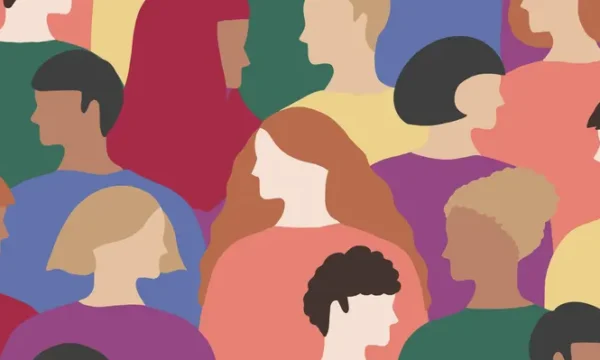
DEI Resource Bank
In this DEI Resource Bank you find the latest research, knowledge and best practices from around the world. Happy reading!
Our picks for you
-
Resource Bank
Pyöriä, P., Koivunen, T., & Lehtovaara, H., 2024
Tutkimus tarkastelee rekrytoinnissa koettua syrjintää Suomessa, erityisesti perhesuhteisiin, vanhemmuuteen ja perheen perustamiseen liittyviä kysymyksiä. Syrjintä kohdistuu erityisesti nuoriin ja varhaiskeski-ikäisiin naisiin, vaikka laki kieltää syrjinnän näillä perusteilla. -
Resource Bank
Tilastokeskus, 2024
Tutkimus osoittaa, että seksuaalinen häirintä on työelämässä yleistä, erityisesti asiakastyössä, ja kohdistuu useimmiten naisiin miesten taholta. Vaikka työpaikan ohjeistukset ja häirintäyhdyshenkilöt eivät välttämättä vähennä häirintää, ne tarjoavat työntekijöille selkeyttä siitä, kenelle häirinnästä voi ilmoittaa. -
Resource Bank
Loi Anh Nguyen, Rebecca Evan, Sanghamitra Chaudhuri, Marcia Hagen, Denise Williams, 2023
This paper brings together different ways in which ‘inclusion’ has been conceptualised, and reviews empirical evidence of how inclusion works in practice. -
Resource Bank
Muutostöissä, 2024
Muutostöissä-podcast haluaa madaltaa työnantajien kynnystä ulkomaalaistaustaisen rekrytointiin. Jaksoissa keskustellaan avoimesti ennakkoluuloista ja ehdollistumista sekä tarjotaan konkreettisia vinkkejä ja esimerkkejä siitä, miten kulttuurinen moninaisuus vaikuttaa yrityksen kilpailukykyyn, tuloksellisuuteen ja työyhteisöön. -
Resource Bank
Inklusiiv, 2024
The article offers strategies to overcome resistance to DEI efforts, focusing on building trust, addressing misconceptions, demonstrating the benefits of inclusion, and engaging stakeholders with empathy and clear communication. -
Resource Bank
TED, 2017
Valerie Alexander explains how the human brain instinctively reacts when encountering the unexpected, like saber-toothed tigers or female tech execs, and proposes that if we have the courage to examine our own behavior when faced with the unfamiliar, we can take control of our expectations, and by doing so, change the world. -
Resource Bank
Harvard Business Review, 2024
The author identifies three things that need to change: 1) Clumsy, jargon-heavy communication, 2) disconnected and decoupled DEI goals and programs, and 3) nonexistent or vanity DEI measurement. They also identify three things that should be maintained: 1) Responsiveness to broader society, 2) commitment to healthy organizations, and 3) the belief that we can be better. -
Resource Bank
Inklusiiv, 2024
The blog post highlights key insights on LGBTQ+ inclusive language, emphasizing its role in creating a culture of belonging by avoiding bias, respecting pronouns, and fostering open communication, while providing practical tips and resources for more inclusive daily interactions. -
Resource Bank
Harvard Business Review, 2023
There’s a body of research that’s been conducted since that 2000 study showing that, while the strategy is generally effective, there are situations in which it might not help you diversify your candidate pool. The author outlines this research, and suggests three questions you should ask in order to get the most out of a blind hiring approach. -
Resource Bank
Inklusiiv, 2024
What is the role of KPIs in advancing DEI strategies and how do these support the DEI work’s outcomes? -
Resource Bank
Deloitte, 2024
Representing the views of 5,000 women from workplaces across 10 countries, the report seeks to understand the lived experiences of women at work—and the ways in which aspects of their lives outside of work can impact these experiences. -
Resource Bank
The European Institute for Gender Equality, 2019
The toolkit introduces key terms and principles for gender-sensitive language, explains when and why to mention gender, and provides examples of language use across an ‘inclusivity scale’ to promote more inclusive communication. -
Resource Bank
Silvia Castro, 2022
This paper uses data for over 500 teams totaling more than 4,300 employees in a global healthcare company to document that workplace cultures where individuals feel safe voicing their ideas associate with innovation, team performance and team stability. -
Resource Bank
Harvard Business Review, 2024
The authors examine the impact of various management practices on diverse representation in managerial roles and how often each management practice is utilized in organizations, shedding light on why organizations are not making greater progress toward diverse representation. -
Resource Bank
Boston Consulting Group, 2024
The article outlines four key sentiments to enhance workplace inclusion and reduce burnout: having good access to resources, senior managerial support, psychological safety with direct manager, and a fair and equal opportunity for success. -
Resource Bank
Harvard Business Review, 2021
In this article the authors describe how rigorous UB programs at Microsoft, Starbucks, and other organizations help employees overcome denial and act on their awareness, develop the empathy that combats bias, diversify their networks, and commit to improvement. -
Resource Bank
Fast Company & Inc, 2024
The article features insights from Alex Edmans of the London Business School, who argues that an overreliance on measuring DEI and ESG undermines progress, as it prioritizes quantifiable outcomes over meaningful action, highlighting the need for nuance, inclusion, and evidence-based decision-making. -
Resource Bank
Harvard Business Review, 2022
The article highlights how DEI initiatives often stall due to tension between DEI leaders and legal teams over risk, arguing that early collaboration and mutual trust can balance legal concerns with impactful, legally informed diversity efforts. -
Resource Bank
Harvard Business Review, 2024
One of the oldest erroneous gender stereotypes is that women are too emotional to be effective leaders, especially in uncertain times. Contrary to this belief, research on 137 leader-report pairs in Europe during the early stages of the Covid-19 pandemic indicates that women may actually be less likely to let their emotions negatively influence their leadership behaviors compared to men. -
Resource Bank
Paradigm, 2024
An analysis of 38,000 employees across 53 organizations found that a higher sense of belonging is strongly correlated with an employee’s engagement, sense of purpose in their work, comfort in sharing their ideas, and trust in their employer. -
Resource Bank
THL, 2024
Tämä opas tarjoaa hyvinvointialueille tietoa ja työkaluja yhdenvertaisuuden ja sukupuolten tasa-arvon edistämiseen omassa toiminnassaan. -
Resource Bank
Harvard Business Review, 2021
The article highlights research showing that adding women to the C-suite leads to changes in corporate strategy and decision-making, with increased emphasis on innovation, risk management, and broader stakeholder interests. -
Resource Bank
Elaine Costa, 2024
This meta-analysis evaluates the effectiveness of interventions to reduce workplace discrimination, finding that passive interventions like short-term education or bias reminders are largely ineffective, while behavior-focused interventions—such as accountability measures and social norm changes—are the most effective in mitigating discriminatory behaviors. -
Resource Bank
Kanitz, R., Reinwald, M., Gonzalez, K., Burmeister, A., Song, Y., & Hoegl, M., 2024
The study identifies four distinct employee response types—excited supporters, calm compliers, torn shapers, and discontent opponents—towards diversity initiatives, highlighting the coexistence of favorable and unfavorable reactions and their varying effects on organizational outcomes. -
Resource Bank
Balázs Vedres & Orsolya Vásárhelyi, 2023
The study demonstrates that gender diversity in teams unlocks greater creativity but only when paired with strong inclusion practices such as cross-gender collaboration and integrating women into core team networks, using video game development as a case study. -
Resource Bank
Diversity VC & VentureESG, 2023
The article introduces a DEI term sheet clause developed by VentureESG and Diversity VC, aimed at ensuring diversity, equity, and inclusion commitments are integrated into venture capital investments. -
Resource Bank
Harvard Business Review, 2024
The author introduces PRISM, a set of five science-backed tools designed to help managers and teams unlearn unconscious biases: Perspective-Taking, pRosocial Behavior, Individuation, Stereotype Replacement, and Mindfulness. These tools aim to improve workplace collaboration, creativity, and communication while reducing conflicts and enhancing performance. -
Resource Bank
Inklusiiv, 2024
The article identifies seven key groups within an organization who play crucial roles in advancing DEI work, emphasizing the need for collaboration and tailored approaches to engage each group effectively. -
Resource Bank
Joseph & Norinsberg, LLC, 2024
The article explores the forms of LGBTQ+ discrimination in the workplace, highlighting legal protections, examples of discriminatory behaviors, and steps employees can take to address unfair treatment. -
Resource Bank
Deloitte, 2024
The report explores the workplace experiences of people with disabilities, chronic health conditions, or who are neurodivergent. The findings offer a comprehensive look into challenges faced in the workplace and the steps employers can take to create inclusive workplaces where everyone can thrive. -
Resource Bank
Deloitte, 2023
The report provides insights on the experiences of 5,474 LGBT+ people in workplaces in various sectors across 13 countries, through the lens of both sexual orientation and gender identity. -
Resource Bank
Pearn Kandola, 2023
While religion is a protected characteristic by law, many organisations overlook it in their existing DEI policies. This report looks at the state of religious inclusion and what can be done to support employees of all faiths at work. -
Resource Bank
Suomen Autismikirjon yhdistys, 2023
Mitä sanoja tulisi käyttää, kun puhutaan autismikirjolla olevista ihmisistä? Kysely selvitti, miten mieltymykset jakautuvat autismikirjon ja autismia kohtaavien ammattilaisten ja läheisten parissa. -
Resource Bank
Culture Amp, 2023
Great managers are crucial, but data from over 300+ companies around the world shows that managers today are highly stressed, juggling conflicting priorities, and in need of more support. -
Resource Bank
Senior Executive, 2023
An easy-to-navigate resource on how to structure employee resource groups, including information on annual ERG budgeting, executive sponsorship, staffing, and event ideas. -
Resource Bank
The Inclusive Growth Show, 2024
A discussion with Ed Warner from Motionspot on the importance of thinking holistically and intersectionally about inclusive design and its benefits for people and businesses. -
Resource Bank
Harvard Business Review, 2023
A/B testing is one robust way to evaluate the impact of some of your DEI initiatives.
-
Resource Bank
Fast Company, 2024
The article lists four of the many ways in which inclusion boosts businesses’ bottom lines—and how to remind leaders about the importance of inclusion in our workplaces. -
Resource Bank
Mildon, 2024
A guide for accessibility and disability inclusion on talent attraction, recruitment, onboarding, retention and workplace adjustments. -
Resource Bank
Catalyst, 2024
This article discusses why it matters how senior leaders frame their commitment to DEI to their employees, and how to do it. -
Resource Bank
CIPD, 2024
This guide is for people professionals and leaders who want to learn more about neurodiversity and how to support neurodivergent colleagues at work. -
Resource Bank
LAB Talk – Pintaa syvemmältä, 2024
Miten yritykset voisivat huomioida ulkomaalaisia työntekijöitä paremmin? Podcastin vieraana suomen kielen lehtori Aija Nurminen.
-
Resource Bank
Boston Consulting Group, 2024
How can organizations create a psychologically safe work environment? It all comes down to empathetic leadership.
-
Resource Bank
Tiedotusosasto, 2024
Miten monikulttuurisuutta johdetaan ja miten siitä kannattaa viestiä? Vieraana kulttuurien välisen vuorovaikutuksen asiantuntija, YTT Katja Keisala. -
Resource Bank
European Institute for Gender Equality, 2023
The Gender Equality Index gives the EU and the Member States a score from 1 to 100. A score of 100 would mean that a country had reached full equality between women and men. -
Resource Bank
Inklusiiv, 2022
Investing in DEI is critical and time-sensitive, but how should it even be done? This blog answers frequent questions and debunks some myths. -
Resource Bank
Inklusiiv, 2023
This blog lays out what allyship is – and what it’s not. -
Resource Bank
Lily Zheng, 2022
By utilizing an outcome-oriented understanding of DEI, along with a comprehensive foundation of actionable techniques, this no-nonsense guide will lay out the path for anyone with any background to becoming a more effective DEI practitioner, ally, and leader. -
Resource Bank
Google, 2023
Learn about the inclusive design process used at Google to create award winning and profitable products. -
Resource Bank
Dr. Poornima Luthra, 2022
It can be tempting to treat DEI as an issue for others to deal with, but whether you are the most junior team member or the most senior executive, inclusion means all, not some. This book answers the question: what can I do? -
Resource Bank
Suvi Keskinen, Minna Seikkula & Faith Mkwesha, 2021
Mitä rasismista pitäisi tietää? Kuka rasismista voi tai saa puhua? Millaista on antirasismi? Teos käsittelee suomalaisessa yhteiskunnassa ennen ja nyt esiintynyttä rasismia ja koloniaalisuutta sekä tuo näkyviin ilmiöiden globaaleja kytköksiä. -
Resource Bank
Farah Harris, 2023
While emotional intelligence is a basic skill, there are more shades to it than you might think. Emotional intelligence can also be used to break barriers to equity. -
Resource Bank
Pragya Agarwal, 2021
The book explores the hidden biases that influence our decision-making, without us even realizing it. It sheds light on these biases and their impact on our choices, providing insights on how to make fairer and more informed decisions in our daily lives. -
Resource Bank
Outi Sivonen, 2022
Käytännön vinkkejä siihen, millaisia johtamisen, osaamisen kehittämisen, perehdytyksen, viestinnän, mukaan ottamisen, jaksamisen tukemisen, inklusiivisuuden ja konfliktinratkaisun toimintatapoja organisaatiossa voidaan ja kannattaa kehittää. -
Resource Bank
Robin Di Angelo, 2022
‘White Fragility’ explores why some white people may become defensive when discussing racism. It examines how this defensiveness can hinder productive conversations about racial inequality and offers insights into fostering more open and constructive dialogue. -
Resource Bank
Shereen Daniels, 2022
This book provides guidance on transforming workplaces to actively combat racism. It offers strategies and tools to create inclusive environments and dismantle discriminatory practices, promoting equity and fairness. -
Resource Bank
C. Otto Scharmer, 2016
Theory U is presents a method for leading from deep awareness to create change and to meet the various challenges organisations and societies face in a more conscious, intentional, and strategic way. -
Resource Bank
Michelle Mijung Kim, 2021
In this book, Michelle MiJung Kim shares foundational principles often missing in today’s mainstream conversations around diversity and inclusion and urges readers to go beyond performative allyship to enacting real transformation within ourselves and in the world. -
Resource Bank
M&A, 2023
Anonyymi rekrytointi on keino taklata ennakkoluuloja työnhaussa. Helsingin kaupunki teetti anonyymin haun vaikutuksista tutkimuksen, joka tuotti harvinaista dataa syistä ja seurauksista. -
Resource Bank
TED, 2009
Novelist Chimamanda Adichie warns that if we hear only a single story about another person or country, we risk a critical misunderstanding. -
Resource Bank
TED, 2010
Brown studies human connection and shares her insights on empathy and the importance of vulnerability. -
Resource Bank
Kielikello, 2023
English is often offered as the common language in multilingual workplaces. However, studies show that there is no single solution that works for all situations and workplaces. What matters is linguistic awareness and flexibility in approaching language issues. -
Resource Bank
Google, 2021
Five steps you can take to start making your meetings more intentionally inclusive. -
Resource Bank
Sateenkaariperheet ry, 2023
Understanding terminology on rainbow families, in Finnish. -
Resource Bank
Fast Company, 2023
Valuable lessons learned in implementing organisational DEI programmes, on the importance of understanding leaders’ priorities, using a balanced approach to data, and setting realistic, achievable goals. -
Resource Bank
Yhdenvertaisuusvaltuutettu, 2023
Key terminology in Finnish -
Resource Bank
Kansan Sivistystyön Liitto KSL ry, 2022
Guidance on how to use language that promotes inclusion and non-discrimination, and is conscious of sexual and gender minorities, anti-racism, disabilities and class. -
Resource Bank
The Management Center, 2021
How to ensure that performance reviews are valuable for employees and management, and remain free of bias? -
Resource Bank
Harvard Business Review, 2023
Employee resource groups can be important vehicles for promoting inclusion and advocating for traditionally underrepresented groups of workers with shared identities and interests. To fulfil this promise, ERGs need resources, budget, and attention. -
Resource Bank
THL, 2023
Findings on wellbeing at work in Finland, before and after the covid pandemic. A growing number of workers in Finland are at risk of burnout. -
Resource Bank
Rights CoLAB, 2022
This report analyses the reporting metrics used by 21 influential organizations to reveal both common core understandings of DEI and significant differences in how DEI is conceptualized, measured, and managed. -
Resource Bank
Journal of Personality and Social Psychology, 2023
The business case for diversity, defined as an instrumental rhetoric claiming that diversity is valuable for organizational performance, can have the effect of hindering organizations’ diversity goals. -
Resource Bank
Diversify, 2023
This white paper examines the current state of diversity and inclusion in Denmark, Finland, Norway, Sweden, and Iceland, revealing workplace discrimination based on race, ethnicity, sexual orientation, and disabilities. -
Resource Bank
Harvard Business Review, 2023
This article introduces seven metrics for measuring an organization’s DEI progress: attrition, performance, promotions, leadership pipeline, employment pipeline, pay equity, and inclusion. -
Resource Bank
Pääkäsittelyssä, 2023
A podcast episode exploring DEI in the legal field, including strategies for addressing challenges at individual and systemic levels. -
Resource Bank
Hidden Brain Media, 2023
A podcast episode exploring our unconscious biases and the relationship between beliefs and behaviors. -
Resource Bank
Project Include, 2023
A guideline that presents tangible strategies to promote DEI within all levels and internal operations of any organization. -
Resource Bank
Sifted, 2022
How could the VC industry can become more inclusive, especially towards the LGBTQIA+ community? -
Resource Bank
Fast Company, 2023
Consider COST, step out of your comfort zone, ask the right questions, and four other ideas on actions anyone can take to create a more inclusive workplace. -
Resource Bank
Atypical Dikkatein, 2023
This is a podcast with several episodes that looks into the lived experience of people who are queer, neurodivergent and disabled in order to build solidarity, intimacy and overall community. -
Resource Bank
Fast Company, 2023
DEI needs to be woven across a business, and keeping it within HR can create too much focus on recruitment and retention. -
Resource Bank
THL, 2023
Tälle sivulle on koottu tietoa sukupuolten tasa-arvon edistämisestä työnantajan ja työpaikan johdon näkökulmasta. -
Resource Bank
Elisa, 2023
This video highlights what actions to advance inclusion looks like in practice at Elisa, a Finnish telecommunications company. -
Resource Bank
Global Alliance, 2023
What can companies do in practice to advance inclusion and become allies, especially to the LGBTQIA+ community? -
Resource Bank
McKinsey, 2023
BIPOC founders and women receive less than 2% of VC funding in the US. Closing this gap is not just the right thing to do—it is also key to driving innovation. -
Resource Bank
Harvard Business Review, 2023
Age discrimination is prevalent, especially towards women. How can we better recognise ageism and create more age diverse organisations? -
Resource Bank
Harvard Business Review, 2018
What are the benefits of diversity within VC firms and how to make them a reality? -
Resource Bank
Pääkäsittelyssä, 2023
A podcast episode that explores the significance of diversity in the legal field, with an emphasis on gender, and discuss the impact of bias and stereotypes, as well as strategies to address and combat these challenges, both on an individual and systemic level. -
Resource Bank
Harvard Business Review, 2022
There is a major demographic shift in the sharp increase of neurodiversity in the workforce. What can we learn from experience about hiring and integrating neurodivergent employees into organisations? -
Resource Bank
Inklusiiv, 2022
Various barriers hold organisations back from driving DEI change. The concept seems abstract, its benefits set so far in the future, and it can be difficult to know what to prioritise. This article outlines fundamental elements that allow organisations to achieve success with their DEI efforts. -
Resource Bank
Accenture, Women in Tech Finland, TEK, Mimmit Koodaa, 2021
Women are ambitious but many still find it hard to thrive in technology roles in Finland. This survey details their experiences of inclusivity and workplace cultures in the tech industry. -
Resource Bank
Inklusiiv, 2021
Recent studies show that over 90% of startup funding in the Nordics and Europe goes to all-male founding teams. This article lists actions investors can take to remedy the situation. -
Resource Bank
Yale Insights, 2021
A case study of gendered bias in performance evaluation data looks at why fewer women are promoted to senior positions than men in a large retail chain in the US. -
Resource Bank
Deloitte, 2023
This survey of 5,000 women across 10 countries aims to better understand women’s career progression and experiences in the workplace. The results show a worrying longer-term impact of the pandemic with respondents reporting burnout at alarmingly high levels. -
Resource Bank
Finnish Venture Capital Association & Inklusiiv, 2023
This guideline presents tangible strategies to promote DEI within internal operations, deal flow processes, and portfolio companies.
-
Resource Bank
Culture Amp, 2022
Disclosing disability in the workplace can be very risky due to biases, assumptions, and stigmas that impact people with disabilities – but in a supportive environment it can also bring benefits in the form of adjustments, accommodations, and getting to be your authentic self. -
Resource Bank
Nokia, 2022
This ebook serves as global guidance to people managers on how to hire, onboard and engage team members with disabilities. It also covers how to improve communication and interaction, and provides guidance for finding more resources. -
Resource Bank
Harvard Business Review, 2021
Why focusing on belonging can help when trying to create cultural change in the workplace. -
Resource Bank
Google, 2022
Strong DEI initiatives are strategic and intentional. Google outlines six lessons they have learned on their DEI journey. -
Resource Bank
Tasa-arvovaltuutettu, 2022
Naisten ja miesten väliset palkkaerot ovat merkittävä ja pitkäkestoinen tasa-arvo-ongelma. -
Resource Bank
Työsuojelu, 2022
Työnantajan tulee edistää työntekijöidensä yhdenvertaisuutta, eikä se saa syrjiä työntekijöitään tai työnhakijoita. Työnantajalla on lisäksi erityisvelvoitteita vammaisia ihmisiä kohtaan, jotta he voisivat saada työtä yhdenvertaisesti muiden kanssa ja suoriutua työtehtävistään. -
Resource Bank
Työsuojelu, 2022
Jos työnantajan palveluksessa olevan henkilöstön määrä on säännöllisesti vähintään 30 työntekijää, työnantajan on vähintään joka toinen vuosi laadittava erityisesti palkkausta ja muita palvelussuhteen ehtoja koskeva tasa-arvosuunnitelma, jonka mukaisesti toteutetaan tasa-arvoa edistävät toimet. -
Resource Bank
Finlex
Tämän lain tarkoituksena on edistää yhdenvertaisuutta ja ehkäistä syrjintää sekä tehostaa syrjinnän kohteeksi joutuneen oikeusturvaa. -
Resource Bank
Finlex
Tämän lain tarkoituksena on estää sukupuoleen perustuva syrjintä ja edistää naisten ja miesten välistä tasa-arvoa sekä tässä tarkoituksessa parantaa naisten asemaa erityisesti työelämässä. Lain tarkoituksena on myös estää sukupuoli-identiteettiin tai sukupuolen ilmaisuun perustuva syrjintä. -
Resource Bank
Oikeusministeriö, 2021
Viimeaikaisten kyselytutkimusten ja selvitysten pohjalta HLBTI-ihmiset kokevat asenteiden heitä kohtaan muuttuneen myönteisempään suuntaan, mutta samalla esille nousee yhä useita epäkohtia esimerkiksi työelämässä, koulutuksessa ja sosiaali- ja terveyspalveluissa. -
Resource Bank
Terveyden ja hyvinvoinnin laitos, 2021
Käytännön neuvoja ja tietoja sukupuolitietoiseen viestintään, joka ottaa sukupuolen merkityksen huomioon sekä viestinnän sisällöissä että käytännöissä. -
Resource Bank
Rare Media, 2022
Käytännönläheinen tietopaketti siitä, kuinka journalistisessa mediassa voidaan vahvistaa moninaisuutta ja yhdenvertaisuutta – niin yksittäisenä journalistina kuin toimitusten ja tiimien voimin. -
Resource Bank
Wrike, 2022
How do you write a staff code of conduct? Here are five steps to follow when getting this document rolled out to your employees. -
Resource Bank
I-sight, 2022
Some outstanding code of conduct examples that you can use as inspiration to update or write your own. -
Resource Bank
Inklusiiv, 2022
Here’s our Code of Conduct. -
Resource Bank
Develop Diverse, 2022
An e-book outlining steps to more inclusive communication and how to start communicating more consciously as an organisation. -
Resource Bank
Contents Magazine, 2012
It’s very important to consider your content from your user’s perspective. Is it written so that your target audience will understand and relate to it? -
Resource Bank
Invisionapp, 2019
Check out these eight stock photo resources that will set you up for design that speaks to people of all walks of life. -
Resource Bank
Futurice, 2022
Strict language requirements are seen as one of the largest career obstacles affecting international professionals. What can companies do to embrace talent who are not well versed in the local language? -
Resource Bank
Microsoft, 2022
An example of a diversity effort in recruitment that seeks to attract talented neurodivergent candidates and provide the training and support they need to succeed. -
Resource Bank
Inklusiiv, 2022
Sometimes simple actions are the most effective. By changing the content of their recruitment ads and making them more inclusive, Tietoevry was able to increase the percentage of women applicants significantly – from 14 % to 32 %. -
Resource Bank
ERE Media, 2021
We have a hard time recognizing talent if it doesn’t look and sound a specific way. This article introduces some systemic solutions to this systemic problem. -
Resource Bank
Futurice, 2022
The success of new products and services depends increasingly on their inclusivity, and how well they meet different end-user needs. The Inclusion canvas is a free-to-use tool designed to help product and service teams make more conscious decisions and cater to broader and more diverse user groups. -
Resource Bank
Microsoft, 2022
Inclusive Design is a methodology that enables and draws on the full range of human diversity. This means including and learning from people with a range of perspectives. -
Resource Bank
European Union Agency for Fundamental Rights, 2020
This report presents select findings from a 2019 survey on LGBTI people in the EU and North Macedonia and Serbia. With almost 140,000 participants, it is the largest survey of its kind.The results show little progress over the past seven years. -
Resource Bank
McKinsey & Company, 2021
Research that provides insights into the participation, plight, and precarity of transgender people at work. -
Resource Bank
McKinsey & Company, 2020
Research reveals the challenges that LGBTQ+ employees face, and six ways to help them bring their authentic selves to work. -
Resource Bank
Inklusiiv, 2022
Pride month is a great opportunity to start dialogues within your company about how to best support your LGBTQ+ employees. However, this dialogue should not end with the month of June. -
Resource Bank
Finnish Venture Capital Association. 2022
This toolkit provides ESG metrics, digital tools, and frameworks for investors and companies to measure environmental, social and governance sustainability. -
Resource Bank
Harvard Business Review, 2019
As organisations take a data-driven approach to identifying areas of change, many encounter one issue: they have a great deal of data about the experiences of certain groups, but far less on others.This article makes a case of analysing and drawing conclusions on small numbers when it comes to employee experiences. -
Resource Bank
Harvard Business Review, 2021
This article includes useful tips on how to measure employee perceptions of inclusion, what effective action looks like from leaders, and common pitfalls to avoid. -
Resource Bank
Crescendo, 2022
Diversity, equity and inclusion (DEI) stretches across the whole organisation, so DEI success metrics should too. This article provides guidance on what D&I metrics to use. -
Resource Bank
Harvard Business Review, 2022
The “add women and stir” approach proposes that having more women present is all that is needed to promote change. But simply adding women into a workplace does not change the organizational structures and systems that benefit men more than women. New research shows how gender bias is still prevalent in gender-balanced and female-dominated industries. -
Resource Bank
Culture Amp, 2022
If you’re considering holding unconscious bias trainings at your company, this article lists some considerations that can help ensure that they work towards your company culture. -
Resource Bank
Harvard Business Review, 2022
An introduction to microaggressions and their negative impact in the workplace. -
Resource Bank
Harvard Business Review, 2022
It can be challenging to recognize and acknowledge our own unconscious biases. Becoming aware of your shortcomings can be one of the best ways to develop as a leader. -
Resource Bank
SHRM, 2021
Developing a team culture where diverse identities and perspectives are welcomed is one impactful way for managers to improve employees’ experiences of inclusion. -
Resource Bank
Harvard Business Review, 2021
Leaders with cultural competence show respect for cultural differences and recognize how those differences drive engagement, productivity, and innovation on their team and throughout their organization. This article lists some strategies for developing this skill. -
Resource Bank
Harvard Business Review, 2020
Inclusive leadership is emerging as a unique and critical capability helping organizations adapt to diverse customers, markets, ideas and talent. Research has found that inclusive leaders share a cluster of six signature traits: commitment, humility, awareness of bias, curiosity about others, cultural intelligence and effective collaborations. -
Resource Bank
Global Studies in Culture and Power, 2020
This piece details cross-cutting influences on anti-racist thought and practice, its historical context and linkages to other traditions of liberatory thought. -
Resource Bank
European Union Agency for Fundamental Rights, 2023
People of African descent in the EU continue to face racism, discrimination and hate crime despite the EU having binding anti-discrimination law in place since 2000. This report presents the latest comparative evidence about the experiences of people of African descent in 13 EU Member States. -
Resource Bank
Antiracism for Beginners
A comprehensive list of antiracism resources compiled during the Black Lives Matter moment in 2020. -
Resource Bank
Harvard Business Review, 2021
Allyship is best thought of as a verb, not a noun. This article details a few situations women of colour may regularly face at work and what their allies can do. -
Resource Bank
TED, 2021
This article includes practical tips on how to become a better ally in the workplace. -
Resource Bank
Forbes, 2020
A survey for women in technology roles, with the objective to understand the inclusivity of workplace cultures in Finland and its impact on how females thrive at work. -
Resource Bank
Boston Consulting Group, 2022
Finland is failing to embrace the business imperative of diversity. This study outlines the current state of play with regards to diversity, equity and inclusion in business in Finland. -
Resource Bank
Inklusiiv, 2022
How to move from awareness of diversity and inclusion to taking action?
Suggest resources that are missing
Visitors can suggest resources to add to the resource bank.

Get Your DEI Dose: Subscribe to Our Monthly Newsletter
Ever wished for a newsletter that doesn’t flood your inbox with spam but delivers only the good stuff—the real gems, the essential insights? Well, look no further. With us, it’s just pure value, 12 times a year. Check our privacy policy for peace of mind and Mailerlite’s policy for the legal details.








